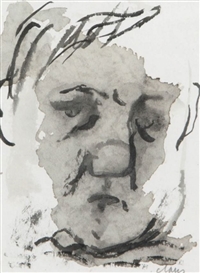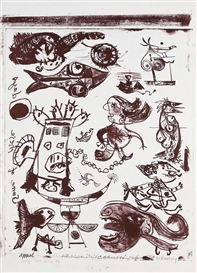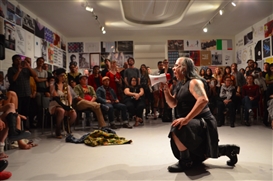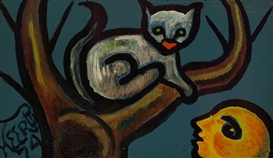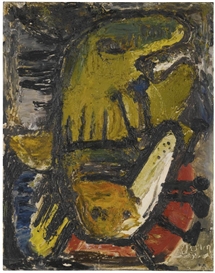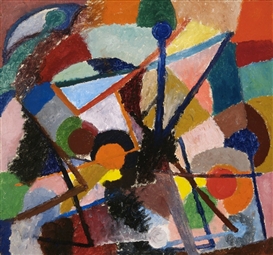Cobra
Cobra MUSÉES ROYAUX DES BEAUX-ARTS DE BELGIQUE, BRUSSELS/COBRA MUSEUM VOOR MODERNE KUNST, AMSTELVEEN, THE NETHERLANDS/STEDELIJK MUSEUM SCHIEDAM, THE
Karen Kurczynski / ARTFORUM
01 Feb, 2009

MUSÉES ROYAUX DES BEAUX-ARTS DE BELGIQUE, BRUSSELS/COBRA MUSEUM VOOR MODERNE KUNST, AMSTELVEEN, THE NETHERLANDS/STEDELIJK MUSEUM SCHIEDAM, THE NETHERLANDS
COBRA REMAINS frequently dismissed as a quaint and childlike pictorial style depicting colorful monsters. But the movement`s legacy is far from simple. Formed in Paris in 1948, Cobra connected an international group of artists (from many more cities than just the "Copenhagen/Brussels/Amsterdam" its acronym indicates) isolated by the war and eager for renewed collaboration. Karel Appel, Constant, Corneille, Christian Dotremont, Asger Jorn, and Joseph Noiret all signed the collective`s manifesto; Pierre Alechinsky and others joined shortly thereafter. Together, they aimed to reanimate modes of spontaneous expression as a collective and materialist endeavor (inspired equally by neoMarxism and by the philosophy of Gaston Bachelard). But the group existed only until 1951, its demise coinciding with the violent division of the world between the two cold-war superpowers - one of which would, of course, successfully claim spontaneous abstraction as its own invention, clothed in the individualist rhetoric of liberal democracy.
Indeed, various European cultural centers manifest competing claims to Cobra as a national heritage - with the ironic effect of marginalizing the group as a marketable, regional modernism, isolated from the international history of postwar avant-gardes. Three recent sixtiethanniversary exhibitions, at the Musées Royaux des BeauxArts de Belgique in Brussels, the Cobra Museum voor Moderne Kunst in Amstelveen, and the Stedelijk Museum Schiedam, presented a rare opportunity to reevaluate a collective still poorly known outside northern Europe (lamentably, the shows omitted the work of Ernest Mancoba, one of the group`s few African members). The exhibitions revisited key moments of Cobra`s fugitive existence, with Amstelveen and Brussels emphasizing, alongside larger artworks, ephemeral projects such as periodicals, artists` books, posters, and collaborations in poetry and painting. One of the primary revelations that emerged was the way in which Cobra artists and poets were likewise transient, consistently changing places and media to striking effect: Witness painter Appel`s bestial sculptures, poet Hugo Claus`s paintings, poet Dotremont`s "word paintings," painter Corneille`s ceramics. Predictably, though, all three shows presented a movement institutionalized, mistakenly aestheticized, and uncritically celebrated as "authentic" expression - when, in fact, Cobra problematized not only the individualist premises of gestural painting but the very possibility of expression itself.
Brussels was the most historically accurate of the shows (even if lighthearted opening fantasies by CarlHenning Pedersen and Henry Heerup still framed Cobra as a movement of charming paintings). There, curator Anne Adriaens Pannier re-created some of Cobra`s more experimental endeavors in assemblage and installation, such as the basket of old clothes in Dotremont`s August 1949 exhibition, "The Object Across the Ages." Aldo Van Eyck`s legendary exhibition designs of 1949 and 1951 had turned the Stedelijk Museum Amsterdam and Belgium`s Palais des Beaux-Arts Liège into three-dimensional modernist grids, with works hung in asymmetrical formations on walls and low pedestals; in Liège, Van Eyck had showcased Heerup`s granite carvings on a bed of raw coal, a materialist accolade worthy of Bachelard. The Brussels display paid careful homage to those installations with large-scale photographs and a selection of Heerup sculptures likewise mounted on coal. Yet a less conventional display, perhaps juxtaposing the multimedia aspects of the group`s production in a more unexpected and integrated way, would have served Cobra better.
All the same, both Brussels and Amstelveen demon- strated well the range of Cobra`s proliferation of means and provisional attitude, from assemblage to photogra- phy to exceptionally vibrant works on paper. Paintings were often made quickly on whatever humble materials were at hand - take, for example, C. O. Hultén`s amend- ment in black paint of a page of newspaper comics (shown in Amstelveen) or the pages of the group`s own journal, Cobra, the fourth issue of which includes a famous col- lage of Titian`s Venus of Urbino with the face of an old, smirking worker (on view in Brussels). Such palimpsests developed Surrealist automatism into an explicitly dialogic expression, conscious but unpremeditated, and responsive to preexisting imagery in ways that anticipated Jörn `s "Modifications" series (which actually had its beginnings in the context of Cobra). Elsewhere in the show, Constant`s canvases represented Cobra painting at its most compelling mobilizing popular symbols, such as animals, as subjective visions of human cruelty and the nightmarish consequences of technological progress. Although Constant`s New Babylon architectural project, 1956-74, would later profoundly critique the institutional recuperation of Cobra painting, his paintings in fact investigate similar issues of social control. Each of these ventures presented an intriguing counterpoint to postwar "death of painting" debates.
Both Amstelveen and Schiedam interspersed Cobra productions with subsequent work by the group`s artists. Schiedam included large-scale paintings by Appel and Theo Wolvecamp from the 1950s and `60s, mostly drawn from the institution`s impressive collection of Dutch Cobra work (amassed as early as the `5Os). These tableaux exert a sheer visual force as monumental assaults on the domestication of painting - their color, gesture, and scale making them feral in both form and content. Such monstrous figures would have been vulgar anathema to the Abstract Expressionists but looked all the more relevant in the context of painting today. Unfortunately, though, the post-Cobra paintings here tended to outshine the earlier pieces dramatically, forcing them into the undeserved position of adolescent flounderings.
We tend to forget the direct physiological impact of Cobra paintings that explicitly reject the transcendent opticality of modernism, seen most effectively in the overwhelming size and brute facture of the mural-scale pieces that Constant, Appel, and Eugène Brands made for the 1949 Cobra exhibition at the Stedelijk Amsterdam. All were shown in Amstelveen, where one could also listen with headphones to recordings of central-African drumming and American blues collected by Brands; yet this experience, limited to a corner of the exhibition, subdued the music`s impact. Why not play it loud in the galleries, as was famously done at the 1949 exhibition opening in Amsterdam? Or project Cobra`s experimental films, which were nowhere to be found? Amstelveen also re-created the group`s "poet`s cage," first exhibited at the Stedelijk Amsterdam - originally a narrow structure of blackpainted wooden beams designed to foreground Cobra`s poetic, printed, and drawn expressions. Here, however, the work was remade with unfinished beams tucked neatly under a staircase to one side of the space, resembling a new museum wing under construction more than a cage.
With more creative installation in a contemporary vein, the museums could have established the radicalism of Cobra, replacing the nostalgic restoration signaled by the endless photographs of days long gone (which postered the central courtyard in Amstelveen) with ongoing cultural interventions. The opportunities to demonstrate Cobra`s resonance with recent practices would have been rich: Their poet`s cage had dramatized the museum as a violently controlled space; Heerup`s sculptures on a bed of coal implied links between raw materials, political power, and community. These works anticipate contemporary interventions within art institutions, such as Guillermo Gómez-Peña and Coco Fusco`s Two Undiscovered Amer-lndians Visit the West performances of 1992, which added the rhetoric of colonial otherness to Cobra`s playful staging of the poet as criminal, and Rirkrit Tiravanija`s/G Reads, 2008, a film and plywood construction documenting poet John Giorno`s writings and studio. In the Tiravanija work, the unfinished construction implied a speculative arena, however modest, rather than an expansion of museal space via materials recuperated from a safely historicized avant-garde.
Outside Denmark, Belgium, and the Netherlands, Cobra is still criticized for the qualities celebrated in those locales: its primitivist inspiration from children`s and outsider art and the paradox of its attempts to politicize painting (a project that was, in fact, always already doomed in the eyes of the Situationist International, formed later in 1957, by Jörn and Constant). Yet the uneven aesthetic "quality" of Cobra`s production - which challenges the very definitions of quality and taste - is a fascinating problem never addressed by the group`s defenders. Moreover, Cobra`s redefinition of gestural expression through disposable and multimedia formats finds its echo in the output of more recent collectives such as the Royal Art Lodge and Forcefield - and it is highly significant that, as history repeats itself, such groups have rarely managed to exist more than a few years without succumbing to some sort of individualist, marketable, and institution-friendly production. To continue to celebrate Cobra blithely in the countries of its origin is to exempt it from the critical debates of a globalized artistic and political discourse with which it would heartily engage if Dotremont or Jörn were around today. I can only hope that the next major Cobra exhibition will present the collective in all its radical contemporaneity: for its insistence on the politics of artmaking, its rejection of specialization, its adamant collectivism, its aesthetic of spontaneity and de-skilling, and its groundbreaking exhibition design. The anniversary shows only saw this legacy through a filter of nostalgia, which ultimately defanged the beast.
SIDEBAR
Cobra is still criticized for the qualities celebrated in its home locales: its primitivist inspiration from children`s and outsider art and the paradox of its attempts to politicize painting.
AUTHOR AFFILIATION
KAREN KURCZYNSKI IS A CRITIC AND ART HISTORIAN BASED IN BOSTON. (SEE CONTRIBUTORS.) KAREN KURCZYNSKI is a critic and art historian who currently teaches modern and contemporary art at the Massachusetts College of Art in Boston. A scholar of the postwar European avant-garde, she recently published articles on Asger Jörn and the Situationist International in the journals Res: Anthropology and Aesthetics and Third Text (both 2008), and her latest essay, "Asger Jörn, Popular Art, and the Kitsch-Avant-Garde," will be included in the collection Kitsch; History, Theory, Practice, from Cambridge Scholars Publishing later this year. Her critical writing has appeared in Art Papers, Woman`s Art Journal, caa.reviews, Nineteenth-Century Art Worldwide, and Billedkunst, where she also serves on the editorial board. In these pages, Kurczynski considers three recent exhibitions celebrating the sixtieth anniversary of the international art group Cobra.
COPYRIGHT: Copyright Artforum Inc. Feb 2009. Provided by Proquest- CSA, LLC. All Rights Reserved. Only fair use as provided by the United States copyright law is permitted.
PROQUEST-CSA, LLC- MAKES NO WARRANTY REGARDING THE ACCURACY, COMPLETENESS, OR TIMELINESS OF THE LICENSED MATERIALS OR ANY WARRANTY, EXPRESS OR IMPLIED.

 ARTISTS
ARTISTS










